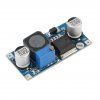johnyradio
Member
Hi
This TI note says we can parallel the LM2587.
https://www.ti.com/lit/an/snva552/snva552.pdf

Is it safe and functional to parallel these off-the-shelf buck modules?
LM2596:
**broken link removed**
https://www.monolithicpower.com/pub/media/document/MP1584_r1.0.pdf

MP1584:
**broken link removed**
https://www.monolithicpower.com/pub/media/document/MP1584_r1.0.pdf

i'm wondering, if their voltages are different, then the higher V will try to dump it's extra into the outputs of the lower V, which seems bad. Maybe could prevent with diodes?
thx!
This TI note says we can parallel the LM2587.
https://www.ti.com/lit/an/snva552/snva552.pdf

Is it safe and functional to parallel these off-the-shelf buck modules?
LM2596:
**broken link removed**
https://www.monolithicpower.com/pub/media/document/MP1584_r1.0.pdf

MP1584:
**broken link removed**
https://www.monolithicpower.com/pub/media/document/MP1584_r1.0.pdf

i'm wondering, if their voltages are different, then the higher V will try to dump it's extra into the outputs of the lower V, which seems bad. Maybe could prevent with diodes?
thx!
Last edited:

